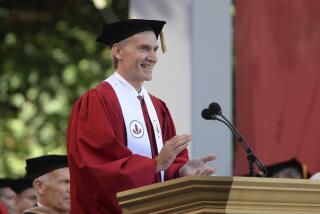NEWS ANALYSIS : Apple’s Split Is More Transition Than Transformation : Management: Several high-tech companies have adopted a dual leadership structure, but the chairman’s role varies widely.
- Share via
SAN FRANCISCO — When Apple Computer announced Friday that John Sculley had stepped aside as chief executive but would remain chairman, it was following in a rich high-tech tradition. Compaq Computer, Intel, Hewlett-Packard and Silicon Graphics all have a dual leadership structure.
The change is also in line with a broader trend in corporate America to split the chairman and CEO positions. It’s a favorite recommendation of shareholder rights advocates, with the recent shake-up at General Motors--where John Smale now serves as chairman and John F. Smith as chief executive--cited as a positive example of the new thinking.
But what the shuffle at Apple really shows is how difficult it can be to establish general principles on such corporate governance issues. Sculley’s new role at Apple bears little resemblance to that of Ben Rosen at Compaq, David Packard at H-P or Tom Perkins at Tandem Computers Inc., even though all are non-executive chairmen.
And the changes at Apple, where Michael Spindler becomes chief executive, won’t create the type of checks and balances between the board and management that many experts believe are necessary.
“At Apple, it appears to be a matter of succession planning and not a matter of policy,” says Nel Minow, principal of Lens Inc., a Washington-based corporate governance group. Thus, she said, it may not have any impact on the relationship between the board and management.
Although there are some superficial similarities between the situations at Apple and Compaq--both Spindler and Compaq CEO Eckhard Pfeiffer are German, for instance--the differences are far more illuminating.
Rosen, a venture capitalist, has been chairman of Compaq since it was founded in 1982. In 1991, when the company began to stumble in the face of fierce competition from lower-cost personal computer vendors, he quickly engineered the ouster of co-founder and CEO Rod Canion.
“We were able to do this within a couple of months, and the way we were organized facilitated that,” says Rosen. “It’s clear that the chairman carries a lot of weight. . . . It would be very hard if you’re just a director and not chairman.”
Under Pfeiffer, Compaq has slashed costs, invigorated its product line and re-established itself as the leading vendor of IBM-compatible PCs.
At Hewlett-Packard, Chairman David Packard also stepped into the fray in 1991 and pushed through crucial organizational changes that have since borne fruit, though CEO John Young kept his job. In contrast, IBM and other computer companies with traditional management structures have been slow to recognize problems and act on them.
Rosen says that separating the chairman and CEO jobs is only one piece of the formula. He says the chairman should not be a former CEO and should not be an employee of the company, and there should be only one member of management on the board of directors.
Apple doesn’t meet any of these criteria, Rosen notes, and thus has taken only “a small step” toward a truly independent board. Similarly, Intel Corp. Chairman Gordon Moore is a former CEO, and there is little reason to believe that the board would act independently of management if Intel got in trouble.
Silicon Graphics Inc., a vendor of powerful graphics computers, might provide the closest analogy to the Apple situation, at least in terms of the roles of the chairmen and chief executives. Founder and Chairman Jim Clark recruited Chief Executive Ed McCracken nine years ago to bring management expertise to the company, and now McCracken runs the firm while Clark focuses on building strategic alliances and plotting long-term technology strategy.
Although some report friction between the two men, McCracken says the arrangement works very well. “In today’s fast-changing world, it’s good to have two people,” he said.
He cites Clark’s success in getting the company into the interactive television business--potentially a huge new market--by negotiating a deal to provide computer systems for a big Time-Warner trial project. But McCracken also notes that in the final analysis, the CEO runs the company and has final say on any deals.
At Apple, Sculley will also be focusing on building the alliances with communications, entertainment and publishing companies that all computer firms will need to compete effectively in the future.
More to Read
Inside the business of entertainment
The Wide Shot brings you news, analysis and insights on everything from streaming wars to production — and what it all means for the future.
You may occasionally receive promotional content from the Los Angeles Times.










